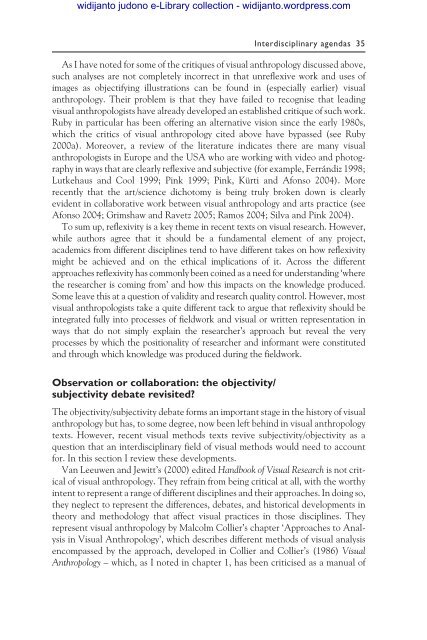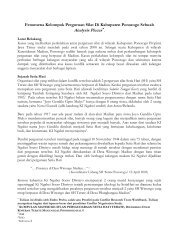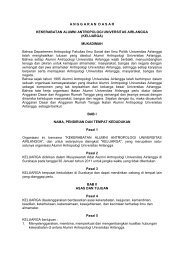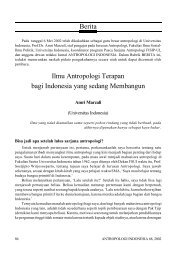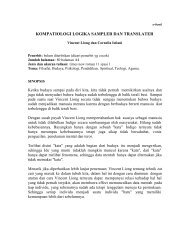The Future of Visual Anthropology: Engaging the Senses
The Future of Visual Anthropology: Engaging the Senses
The Future of Visual Anthropology: Engaging the Senses
You also want an ePaper? Increase the reach of your titles
YUMPU automatically turns print PDFs into web optimized ePapers that Google loves.
widijanto judono e-Library collection - widijanto.wordpress.com<br />
As I have noted for some <strong>of</strong> <strong>the</strong> critiques <strong>of</strong> visual anthropology discussed above,<br />
such analyses are not completely incorrect in that unreflexive work and uses <strong>of</strong><br />
images as objectifying illustrations can be found in (especially earlier) visual<br />
anthropology. <strong>The</strong>ir problem is that <strong>the</strong>y have failed to recognise that leading<br />
visual anthropologists have already developed an established critique <strong>of</strong> such work.<br />
Ruby in particular has been <strong>of</strong>fering an alternative vision since <strong>the</strong> early 1980s,<br />
which <strong>the</strong> critics <strong>of</strong> visual anthropology cited above have bypassed (see Ruby<br />
2000a). Moreover, a review <strong>of</strong> <strong>the</strong> literature indicates <strong>the</strong>re are many visual<br />
anthropologists in Europe and <strong>the</strong> USA who are working with video and photography<br />
in ways that are clearly reflexive and subjective (for example, Ferrándiz 1998;<br />
Lutkehaus and Cool 1999; Pink 1999; Pink, Kürti and Afonso 2004). More<br />
recently that <strong>the</strong> art/science dichotomy is being truly broken down is clearly<br />
evident in collaborative work between visual anthropology and arts practice (see<br />
Afonso 2004; Grimshaw and Ravetz 2005; Ramos 2004; Silva and Pink 2004).<br />
To sum up, reflexivity is a key <strong>the</strong>me in recent texts on visual research. However,<br />
while authors agree that it should be a fundamental element <strong>of</strong> any project,<br />
academics from different disciplines tend to have different takes on how reflexivity<br />
might be achieved and on <strong>the</strong> ethical implications <strong>of</strong> it. Across <strong>the</strong> different<br />
approaches reflexivity has commonly been coined as a need for understanding ‘where<br />
<strong>the</strong> researcher is coming from’ and how this impacts on <strong>the</strong> knowledge produced.<br />
Some leave this at a question <strong>of</strong> validity and research quality control. However, most<br />
visual anthropologists take a quite different tack to argue that reflexivity should be<br />
integrated fully into processes <strong>of</strong> fieldwork and visual or written representation in<br />
ways that do not simply explain <strong>the</strong> researcher’s approach but reveal <strong>the</strong> very<br />
processes by which <strong>the</strong> positionality <strong>of</strong> researcher and informant were constituted<br />
and through which knowledge was produced during <strong>the</strong> fieldwork.<br />
Observation or collaboration: <strong>the</strong> objectivity/<br />
subjectivity debate revisited?<br />
Interdisciplinary agendas 35<br />
<strong>The</strong> objectivity/subjectivity debate forms an important stage in <strong>the</strong> history <strong>of</strong> visual<br />
anthropology but has, to some degree, now been left behind in visual anthropology<br />
texts. However, recent visual methods texts revive subjectivity/objectivity as a<br />
question that an interdisciplinary field <strong>of</strong> visual methods would need to account<br />
for. In this section I review <strong>the</strong>se developments.<br />
Van Leeuwen and Jewitt’s (2000) edited Handbook <strong>of</strong> <strong>Visual</strong> Research is not critical<br />
<strong>of</strong> visual anthropology. <strong>The</strong>y refrain from being critical at all, with <strong>the</strong> worthy<br />
intent to represent a range <strong>of</strong> different disciplines and <strong>the</strong>ir approaches. In doing so,<br />
<strong>the</strong>y neglect to represent <strong>the</strong> differences, debates, and historical developments in<br />
<strong>the</strong>ory and methodology that affect visual practices in those disciplines. <strong>The</strong>y<br />
represent visual anthropology by Malcolm Collier’s chapter ‘Approaches to Analysis<br />
in <strong>Visual</strong> <strong>Anthropology</strong>’, which describes different methods <strong>of</strong> visual analysis<br />
encompassed by <strong>the</strong> approach, developed in Collier and Collier’s (1986) <strong>Visual</strong><br />
<strong>Anthropology</strong> – which, as I noted in chapter 1, has been criticised as a manual <strong>of</strong>


